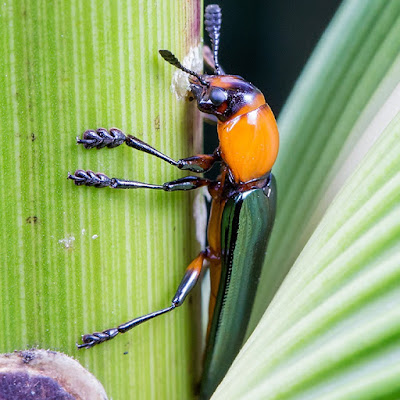[Most Recent Entries] [Calendar View]
Monday, July 16th, 2018
| Time | Event | ||||||
| 9:14a | [Entomology • 2018] A Taxonomic Review of the Genus Callilanguria Crotch, 1876 (Coleoptera: Erotylidae: Languriinae)
Abstract A worldwide review of the genus Callilanguria is presented. Three new species are described: Callilanguria weiweii Huang & Yang, sp. nov. from Sabah, Malaysia; C. helleri Huang & Yang, sp. nov. from Panay, the Philippines; and C. nigripes Huang & Yang, sp. nov. from Samar Island, the Philippines. Callilanguria scrupulosa Heller, 1918 is transferred to the genus Doubledaya. The other species are C. eximia Fowler, 1885; C. gorhami Villiers, 1945; C. asymmetrica Heller, 1900; C. ruficeps Achard, 1923; C. milloti Villiers, 1945; C. stenosoma (Harold, 1879); C. flaviventris Fowler, 1886; C. wallacii Crotch, 1876; and C. luzonica Crotch, 1876. In total, twelve species are recognized in the genus Callilanguria, and a key to the described species of the genus is provided. Keywords: Coleoptera, Cucujoidea, new species, new combination, Doubledaya, Oriental region Zheng-Zhong Huang, Xin-Yu Han and Xing-Ke Yang. 2018. A Taxonomic Review of the Genus Callilanguria Crotch, 1876 (Coleoptera: Erotylidae: Languriinae). Zootaxa. 4446(1); 97–110. DOI: 10.11646/zootaxa.4446.1.7 | ||||||
| 11:33a | [Herpetology • 2018] Vermicella parscauda • A New Species of Bandy-bandy (Vermicella: Serpentes: Elapidae) from the Weipa Region, Cape York, Australia
Abstract Bandy-bandies (genus Vermicella) are small (50–100cm) black and white burrowing elapids with a highly specialised diet of blindsnakes (Typhlopidae). There are currently 5 recognized species in the genus, all located in Australia, with Vermicella annulata the most encountered species with the largest distribution. Morphological and mitochondrial analyses of specimens collected from the Weipa area, Cape York, Queensland reveal the existence of a new species, which we describe as Vermicella parscauda sp. nov. Mitochondrial DNA analysis (16S and ND4) and external morphological characteristics indicate that the closest relatives of the new species are not V. annulata, which also occurs on Cape York, but rather species from Western Australia and the Northern Territory (V. intermedia and V. multifasciata) which, like V. parscauda, occupy monsoon habitats. Internasal scales are present in V. parscauda sp. nov., similar to V. annulata, but V. intermedia and V. multifasciata do not have nasal scales. V. parscauda sp. nov. has 55–94 black dorsal bands and mottled or black ventral scales terminating approximately 2/3rds of the body into formed black rings, suggesting that hyper-banding is a characteristic of the tropical monsoon snakes (V. intermedia, V. multifasciata and V. parscauda). The confined locality, potential habitat disruption due to mining activities, and scarcity of specimens indicates an urgent conservation concern for this species. Keywords: Reptilia, Australian Monsoonal Tropics, mtDNA, taxonomy, Vermicella parscauda sp. nov. Chantelle M. Derez, Kevin Arbuckle, Zhiqiang Ruan, Bing Xie, Yu Huang, Lauren Dibben, Qiong Shi, Freek J. Vonk and Bryan G. Fry. 2018. A New Species of Bandy-bandy (Vermicella: Serpentes: Elapidae) from the Weipa Region, Cape York, Australia. Zootaxa. 4446(1); 1–12. DOI: 10.11646/zootaxa.4446.1.1 | ||||||
| 2:02p | [Botany • 2018] Hippeastrum lunaris & H. mauroi • Two New Critically Endangered Species of Hippeastrum (Amaryllidaceae) from the Brazilian Cerrado
Abstract Monographic work on the genus Hippeastrum in Brazil has revealed two new species endemic to the Cerrado biome, here described and illustrated. Hippeastrum lunaris is a species restricted to the region of Chapada dos Veadeiros; H. mauroi is so far found only in Chapada dos Guimarães. Detailed descriptions, illustrations and taxonomic comments on the conservation status of these species are provided, in addition to comparisons with morphologically similar species. An identification key to the species of Hippeastrum occurring in the Brazilian Cerrado is presented, accompanied by photographs of these species in their natural habitats. Keywords: Endemism, Hippeastreae, taxonomy, threatened species, Monocots Hippeastrum lunaris Campos-Rocha & Meerow sp. nov. Hippeastrum lunaris is similar to H. morelianum Lemaire (1845: 37) and can be separated readily by underground bulb (vs. exposed) and the paraperigone of free and loose fibrae (vs. fimbrae partially connate). It appears related to H. leucobasis (Ravenna 1978: 90) Dutilh in Meerow et al. (1997: 18) but differs by the staminal filaments shorter than the perigone and its trifid stigma (vs. filaments exceeding the perigone and a capitate stigma in H. leucobasis). Type:— BRAZIL. Goiás: Colinas do Sul, campo sujo com mata inundável adjacente, área a ser inundada, 18 December 1996, L.B. Bianchetti 1502 (holotype CEN [photo!]; isotype UB!; UEC!). Etymology:— The specific epithet refers to the Vale da Lua, to where the species is confined. The area is so named because of its rock formations along the banks of the ribeirão São Miguel, considered similar to lunar craters
 
Hippeastrum mauroi Campos-Rocha & Dutilh, sp. nov. Hippeastrum mauroi is similar to H. puniceum and H. reginae (Linnaeus 1759: 977) Herbert (1821: 31) but can be distinguished from both by its uniflorous inflorescence (vs. 2–4, except rarely one in H. puniceum), different color pattern at the base of the tepals, the paraperigone devoid of fimbrae (vs. fimbrae present), and the style up to 1/2 of the perigone length (vs. 2/3 or more). Type:— BRAZIL. Mato Grosso: Chapada dos Guimarães, área de Cerrado ralo próxima ao Parque Nacional da Chapada dos Guimarães; florescimento em cultivo no Jardim Botânico Plantarum, 21 August 2013, A. Campos-Rocha & G. Bellozi 1215 (holotype UEC!). Etymology:— The specific epithet is in honor of our friend Mauro Peixoto, who collected and introduced us to this and so many other plants new to science. Mauro has a unique knowledge about Brazilian native plants, a result of decades of study and observation in the field, having collaborated actively with various scientists over the years. Antonio Campos-Rocha, Alan William Meerow and Julie Henriette Antoinette Dutilh. 2018. Two New Critically Endangered Species of Hippeastrum (Amaryllidaceae) from the Brazilian Cerrado. Phytotaxa. 360(2); 91–102. DOI: 10.11646/phytotaxa.360.2.1  |
| << Previous Day |
2018/07/16 [Calendar] |
Next Day >> |








